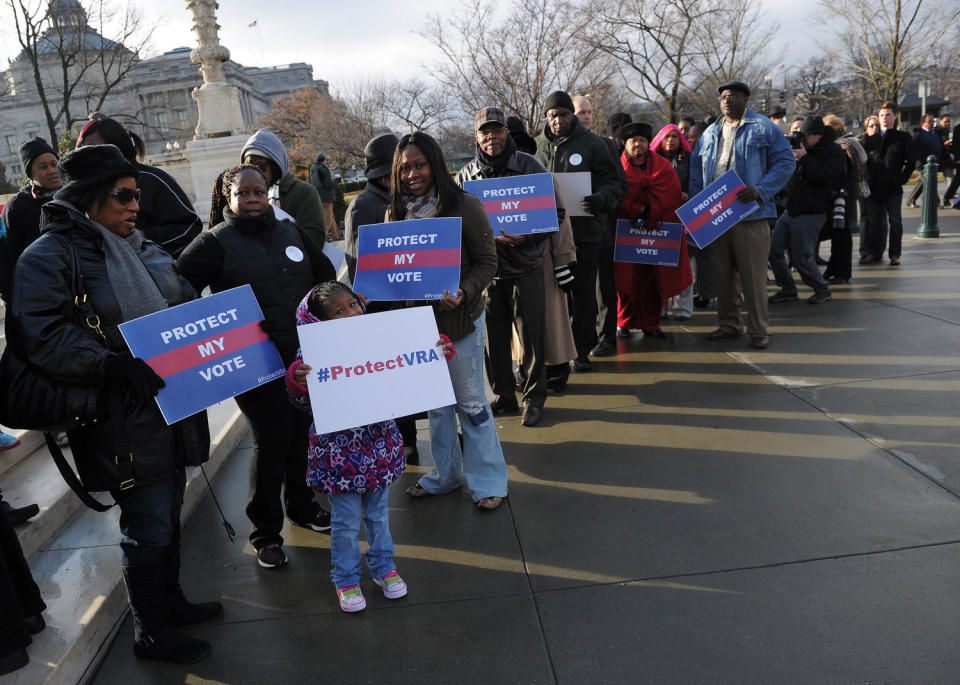The turnout gap between white and Black voters is growing, study finds
The difference in turnout between white and nonwhite voters has grown over the last decade, a report released Saturday from the Brennan Center for Justice found — and a major contributor appears to be a Supreme Court decision weakening the Voting Rights Act.
The findings of the report have sparked fears about the health of American democracy from experts at the Brennan Center, a left-leaning think tank that analyzes voting rights, elections, money in politics, gerrymandering and more.
“It is just not acceptable to have a democracy that not only systematically sees lower participation from voters of color, but where that gap in participation is consistently growing,” Wendy Weiser, vice president for democracy at the Brennan Center, told NBC News.
“The sheer magnitude of the racial turnout gap, I think, is alarming and should alarm all of us,” Weiser added.
The report found that the growing racial turnout gap is in part due to the Supreme Court’s 2013 decision in Shelby County v. Holder, which suspended Section 5 of the 1965 Voting Rights Act. The racial turnout gap “is growing most quickly in parts of the country that were previously covered under Section 5,” the report found.

Section 5 was a measure that forced jurisdictions with a history of racial discrimination against Black voters to seek approval from the Justice Department for any changes to voting laws or processes.
“The factor that sort of rose up as actually being a marked driver of that turnout gap was whether or not a county was previously subject to federal oversight under the Voting Rights Act before that Shelby County decision,” Weiser said.
The new restrictions on voting that have passed across the country since the Supreme Court case are significant contributors to the turnout gap, she added.
“We’ve been documenting a huge spike in restrictive voting laws across the country,” Weiser said. “The laws and the voting restrictions that are adopted ... pile on top of each other.”
“Standing alone, each restriction might have an impact that’s hard to assess or measure,” she continued. “But as they start piling on, you might be able to see whether or not they’re having an impact on the voting process.”
And that impact, the report found, is present across the U.S., not just in counties that were previously covered by Section 5.
Across all regions, the racial turnout gap was higher in the 2022 midterms than in any midterm elections since 2006, the report said.
Between the 2018 and 2022 midterm elections alone, the turnout gap grew by 5 percentage points between white voters and nonwhite voters, and it grew by 8 points between white voters and Black voters specifically, researchers found.
Kevin Morris and Coryn Grange, the report’s co-authors, emphasized that the number of nonwhite voters staying home has the power to change elections.
They wrote that if the gap had not existed in the 2020 presidential election, “nine million more ballots would have been cast — far more than the seven million by which Joe Biden won the national popular vote.”
“The gap matters for our political system,” they added.
Their research and analysis was based on a database of nearly a billion voting record files from across the country, and they believe their analysis is the first of its kind to use such a large dataset to measure voter turnout rates.
The report calls for scholars to continue looking into the best ways to close the racial turnout gap, but the overarching recommendation from the report is to restore the full Voting Rights Act.
“A fully functional Section 5 of the Voting Rights Act would improve conditions in areas where racial discrimination remains in voting policy,” Morris and Grange write.
Their recommendation is one that may be harder to achieve than it seems.
While Democrats prioritize measures they say would promote voting rights and have introduced the John R. Lewis Voting Rights Advancement Act in Congress, Republicans are largely not on board, arguing that Democratic-backed proposals could lead to fraud.
Still, Weiser said, “My hope is that — and this I don’t anticipate in the immediate future — but that there will be Republican support in Congress for these reforms as well.”
“The votes that are lost when we make it harder to vote are not just Democratic votes. They’re Democratic votes, Republican votes and independent votes,” she added.
This article was originally published on NBCNews.com

